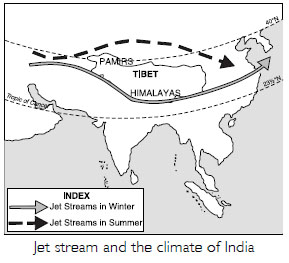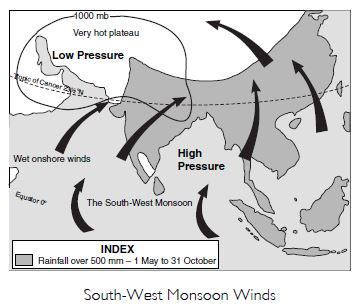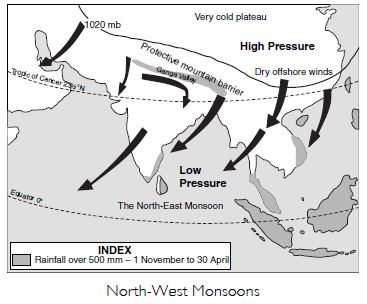Question 1:
Which one of the following places receives the highest rainfall in the world?
- Silchar
- Mawsynram
- Cherrapunji
- Guwahati
Answer:
(b) Mawsynram
Question 2:
The wind blowing in the northern plains in summer is known as:
- Kaal Baisakhi
- Loo
- Trade winds
- None of these
Answer:
(b) Loo
Question 3:
Which one of the following causes rainfall during winters in north-western part of India?
- Cyclonic depression
- Retreating Monsoons
- Western disturbances
- Southwest Monsoons
Answer:
(c) Western disturbances
Question 4:
Monsoon arrives in India approximately in:
- Early May
- Early July
- Early June
- Early August
Answer:
(c) Early June
Question 5:
Which one of the following characterises the cold weather season in India?
- Warm days and warm nights
- Warm days and cold nights
- Cool days and cold nights
- Cold days and warm nights
Answer:
(c) Cool days and cold nights.
Question 6:
What are the controls affecting the climate of India?
Answer:
The climate of India is affected by the following geographical factors:
(a) Monsoon winds: India’s climate is controlled by the monsoon winds. In summers, monsoons
are onshore winds. These winds cause most of the rainfall in the sub-continent. In winters,
the
monsoon winds blow from land to sea as N.E. Monsoons. These are dry winds.
(b) Extent of the country: India is a vast country. The northern part lies in the temperate
region
and experiences hot summers and cool winters. The southern part lies nearer to the equator
and has a hot season throughout the year.
(c) Location of the Himalayas: The Himalayas act as a climatic barrier. This mountain wall
protects
India from the cold winds of Central Asia from entering India during winter. The Himalayas
check the onshore S.W. Monsoons and prevent them from escaping the sub-continent, thus
causing rainfall.
(d) The Indian Ocean: India lies at the head of the Indian Ocean. S.W. Monsoons originate
from
this ocean in summer and cause rainfall over most of the country. Cyclones also originate
over
this ocean.
(e) The Western disturbances: The western disturbances (cyclones) originate from the
Mediterranean Sea and enter India in winter. These provide rainfall in the N.W. parts of
India
in winter.
(f) Distance from the sea: The coastal areas experience maritime climate. These areas have
equable climate. But the areas in the interior experience extreme or continental type of
climate
such as N.W. India.
(g) Relief of the land: Relief influences the distribution of temperature and rainfall in
India.
Mountainous areas have low temperature. The windward slopes such as Western Ghats receive
heavy rainfall while the leeward slopes (Deccan Plateau) lie in the Rain-shadow and are dry.
Question 7:
Why does India have a monsoon type of climate?
Answer:
The Indian Sub-continent extends from 8 North to 37 North latitudes. So, it has a tropical location. The Himalayas provide an enclosed character to the sub-continent. The Indian Ocean in the South gives it a hot monsoon climate. As a result, India has essentially a tropical monsoon climate. The Tropic of Cancer divides the country into two halves. The northern half lies in the temperate zone while the southern half lies in the tropical zone. Hence, India has high temperatures throughout the year and most of the rain takes place in summer.
Question 8:
Which part of India does experience the highest diurnal range of temperature and why?
Answer:
The Thar desert has high diurnal or daily range of temperature. The difference between the daily maximum and daily minimum temperature is large. The sandy soils become heated during the day and cool down during the night.
Question 9:
Which winds account for rainfall along the Malabar Coast?
Answer:
Malabar coast lies on the West Coast, facing the Western Ghats. The Arabian Sea branch of the monsoons are onshore moisture-laden winds and cause heavy rainfall on the western slopes of the Western Ghats and the West Coast. S.W. Monsoon winds first strike the Malabar coast causing heavy rainfall called a ‘monsoon burst’.
Question 10:
What are Jet streams and how do they affect the climate of India?
Answer:
Jet streams are fast flowing winds blowing in a narrow zone in the upper atmosphere. The Himalayas divide the jet streams into two parts. The westerly jet streams (27–30º N) blows over the south of the Himalayas during the winter season. The easterly jet streams develop at about 14N in summer. It is believed to be responsible for the sudden outbreak of monsoons in Northern India. It causes widespread storms, thunder and rainfall over India in just 8 to 10 days.

Question 11:
Define monsoons. What do you understand by ‘break’ in monsoon?
Answer:
Monsoons are seasonal winds. These change their directions with the season. Monsoon starts all of a sudden and is called the break in monsoons.
Question 12:
Why is the monsoon considered a unifying bond?
Answer:
There is a great diversity in climatic conditions of India due to differences in relief features. Examples: (a) Due to monsoon winds, India has a monsoon type of climate throughout the country. (b) The whole country is influenced by the same order of seasons. (c) The monsoonal rhythm of seasons is a great unifying force in India. (d) Monsoons control the atmospheric conditions of the country. Throughout the country, the summers are wet and the winters dry due to onshore winds. The distribution of rainfall is uneven. (e) Agriculture depends upon monsoonal rainfall resulting in a subsistence agriculture. Agriculture in India is a gamble in monsoons. (f) The folk songs like Kajari of Bhojpur and Malhar of Braj are associated with monsoonal rains. (g) Thus, monsoons provide a natural base for a uniformity throughout the country.
Question 13:
Why does the rainfall decrease from the east to the west in Northern India?
Answer:
The Bay of Bengal branch of monsoons move from east to west. These move up the Ganga Valley along the Himalayas. As these winds move westward, these become drier and cause less rainfall. Kolkata gets an annual rainfall of 162 cm, Patna 102 cm, Allahabad 91 cm and Delhi gets 56 cm of rainfall.
Question 14:
Give reason as to why.
Seasonal reversal of wind direction takes place over the Indian subcontine
Answer:
Mechanism of Monsoons
The N.E. trade winds are replaced by the monsoons. The S.E. trade winds of the southern
hemisphere
after crossing the equator become S.W. monsoons. The dry and hot winds are replaced by wet
monsoons during the summer seasons. The mechanism of the monsoon is from temperature,
through pressure and winds to rainfall.
Due to high temperatures, a low pressure develops over the North-West part of India. This is basically responsible for the reversal of wind direction and rise of S.W. monsoons. Thus, it was originally thought that monsoons have a thermal origin and these are surface winds. But nowadays, the meteorological data has proved that upper air winds and currents also play an important role in the mechanism of monsoons. The jet streams also affect the mechanism of monsoons. The eastern branch of jet streams is believed to be responsible for the sudden break of monsoons and cause heavy rainfall.
Question 15:
Give reason as to why.
The bulk of rainfall in India is concentrated over a few months.
Answer:
The bulk of rainfall in India is received during the four months of the rainy season, i.e., June, July, August and September. This is the period of South-West monsoons blowing from sea to land. These sea to land winds are the rain giver, as these moisture-laden winds are onshore winds. The tropical cyclones add to the amount of rainfall. Easterly tropical jet streams, too, help in rains during this period.
Question 16:
Give reason as to why.
The Tamil Nadu coast receives winter rainfall.
Answer:
The Konkan Coast faces the onshore S.W. monsoons during summer. These moisture-laden
winds cause heavy rainfall (more than 300 cms). But these winds do not give much rainfall on
the
Coromandel Coast as it lies in the rain shadow area of the Western Ghats. The Coromandel
Coast
receives winter rainfall from N.E. monsoons, but on the Konkan Coast, these winds are
offshore
and do not give any rainfall. Thus, Coromandel Coast gets rainfall in both the seasons, but
the total
amount is less than that of Konkan Coast. Total rainfall in Chennai is 128 cms, but it is
180 cms at
Mumbai.
Tamil Nadu gets most rain from North-East monsoons in October and November. These winds
after picking up moisture from the Bay of Bengal give more rain on the East Coast. Thus,
Tamil Nadu
gets most rain in winter when the fury of monsoons is over in most parts of the country.
Question 17:
Give reason as to why.
The delta region of the eastern coast is frequently struck by cyclones.
Answer:
Tropical cyclones are depressions originating over the Bay of Bengal. These tropical cyclones are often very destructive. They cause heavy rains. These cyclones strike West Bengal and Bangladesh (Ganga Delta). These cross the eastern coast and affect the states of Odisha, Andhra Pradesh, Tamil Nadu and Kerala. The thickly populated deltas of Mahanadi, Godavari, Krishna and Kaveri are their targets.
Question 18:
Give reason as to why.
Parts of Rajasthan, Gujarat and the Leeward side of the Western Ghats are drought prone.
Answer:
The western part of Rajasthan is a desert. It gets an annual rainfall of less than 20 cms.
This is due
to the following reasons:
(a) Rajasthan is under the influence of the S.W. summer monsoons. The Aravallis system lies
parallel to the direction of S.W. monsoons coming from the Arabian Sea. These low mountain
system is unable to check these winds. So, western Rajasthan is practically dry. The
southern
parts get some rainfall.
(b) This area lies at a great distance from the Bay of Bengal. The Bay of Bengal monsoons
become
dry and lose their moisture when they reach Rajasthan.
(c) This area is away from the Himalayan region. So it does not come under the influence of
monsoons, giving rain in the sub-Himalayan region.
(d) Gujarat has high variability of rainfall. So it is a drought prone area.
(e) The leeward slopes of Western Ghats is in rain shadow area.
Question 19:
Describe the regional variations in the climatic conditions of India with the help of suitable examples.
Answer:
Due to the vast size of India, many regional variations in climatic conditions are found. But
due to
the influence of monsoons, India has a broad unity of Monsoon type of climate having the
same
rhythm of season. Many factors like location, altitude, distance from the sea, general
relief produce
regional variations in pattern of winds, temperature and rainfall. The examples given below
illustrate
the climatic differences:
(i) Temperature: Barmer (Rajasthan) has recorded the highest day temperatures of 50C in
summer, and 15C at night, while hilly regions like Gulmarg (Kashmir) have a day temperature
of 20C in June. The winter temperatures at Dras and Kargil (Leh) drops as low as –45C, on
the other hand Chennai may record only 20C in December. The annual range of temperature
is about 12C at Cochin while it is about 40C in Punjab. Coastal regions have almost uniform
temperatures throughout the year.
(ii) Rainfall: The striking differences are found in rainfall pattern. Mawsynram (Meghalaya)
with an
annual rainfall of 1140 cm is the rainiest place in the world, while Jaisalmer (Rajasthan)
rarely
gets more than 12 cm of annual rainfall and Leh gets only 10 cm rainfall. The Western
coastal
plain gets rain-storms while the Coromandel coast remains dry. When the Brahmaputra valley
is
submerged in floods, it brings drought in Bihar.
(iii) Monsoons: The dates of onset and withdrawal of monsoons differ in various parts. The
west coast
gets monsoons in the first week of June, while the interior parts like Punjab receive
monsoons by
the first week of July.
(iv) Seasons: The southern parts of the country have uniformly high temperatures throughout
the
year. There is no winter season in the south. On the other hand, seasonal extremes are found
in
the north. In summer, a heat wave is produced, called Loo whereas, a cold wave is felt in
winter.
Question 20:
Discuss the mechanism of monsoons.
Answer:
Currently, the mechanism of the monsoon is a widely-studied subject globally. In the Indian
subcontinent, the mountain barriers to the north guide the flow of the monsoon winds. The
Western Ghats, too, play a similar role.
To understand the mechanism of the monsoons. Certain factors are responsible for the cause
of
the wind-reversal.
(i) The less heat around the Arabian Sea is caused due to intensive heating during the
premonsoon
months.
(ii) The northernmost position of Inter-Tropical Convergence Zone (ITCZ) in summer, also
known
as the monsoon-trough during the monsoon season.
(iii) High Pressure on the Indian Ocean. The intensity and position of this high-pressure
area over
the Indian ocean affects the Indian Monsoon.
(iv) The Tibetan high-level plateau gets intensely heated during summer, which results in
strong
vertical air currents and the formation of high pressure over the plateau at about a
kilometre
above the sea level.
(v) The movement of the westerly jet streams to the north of the Himalayas and the presence
of
the tropical easterly jet streams over the Indian peninsula during summer.
Question 21:
Give an account of weather conditions and characteristics of the cold seasons.
Answer:
The Cold Season: The cold season lasts from January to February.
(i) Temperature: The sun is overhead at the Tropic of Capricorn. The Indian sub-continent
has
winter season. January is the coldest month. The southern parts have warm conditions
(20C)
while low temperatures (10C) are found in N.W. India and the Trans-Himalayan region of
Jammu and Kashmir, which are the coldest parts of India. The minimum temp. of –40C are
recorded at Dras or Kargil (Ladakh).
(ii) Pressure and Winds: High pressure developes over N.W. part, while a low pressure exists
over
the Indian Ocean. As a result, winds blow from land to sea.
(iii) Rainfall: The N.E. Monsoons being offshore winds are dry. But these winds pick up some
moisture
while crossing the Bay of Bengal and deliver rain to the S.E. coast of India. Some cyclones
from
the Mediterranean Sea cause rainfall (10–20 cm) on the Northern Plains. Leh receives
snowfall.
Question 22:
Give the characteristics and effects of the monsoon rainfall in India.
Answer:
Characteristics of rainfall in India: The average annual rainfall in India is about 110 cms.
It is estimated
that more than 85% of this rainfall is received in summer. The main characteristics of
summer rainfall
are as follows:
(i) Monsoonal rainfall: Most of the rain is received from the S.W. summer monsoons during
the
period mid-June to mid-September. It is seasonal rainfall.
(ii) Uncertain rainfall: Summer rainfall is quite uncertain. Some times monsoons start early
resulting
in floods. Often the onset of monsoons is delayed resulting in drought. The early or late
retreat
of monsoons also results in severe droughts.
(iii) Unequal distribution: The rainfall is unevenly distributed over the country. About 10%
of the
country gets more than 200 cm of rain while 25% of the country gets less than 75 cm of
rain.
(iv) Heavy rainfall: Indian rainfall is heavy. It is often said that ‘‘It pours, it never
rains in India.’’
(v) Relief rainfall: The amount of rainfall is determined by the presence of mountains. High
mountains
force monsoons to rise and cause rainfall.
(vi) No continuity of rainfall: Summer rain is characterised by breaks or dry spells.
(vii) Variable rainfall: Most of the areas have variable rainfall, as much as 30 cm plus or
minus. Due
to variability in areas of low rain, famines are formed.
Question 23:
Why the houses in Rajasthan have thick walls and flat roofs?
Answer:
Houses in Rajasthan have thick walls:
(i) During summers, extreme heat is experienced during the days. The thick walls do not
allow the heat to enter inside the houses. It absorbs heat and keeps the house cool.
Similarly in winter, thick walls of the houses do not allow the cold winds to enter the
house, keeping it warm.
Houses in Rajasthan have flat roofs:
(i) Flat roofs are considered ideal for keeping the house cold during the summer months and
warm during the winter months.
Question 24:
Why is it that the houses in the Tarai region and in Goa and Mangalore have sloping roofs?
Answer:
The houses in the Tarai region and in Goa and Mangalore have slopping roofs as these areas receive heavy rainfall. The slopping roof does not allow rain water to accumulate on roof-tops. Thus, slopping roofs keeps the house safe in this region.
Question 25:
Why houses in Assam are built on stilts?
Answer:
Houses in Assam are built on the stilts, as stilts allows the free flow of water. It also avoids wetness and danger from poisonous reptiles which can enter the houses.
Question 26:
Why most of the world’s deserts are located in the western margins of continents in the subtropics?
Answer:
As these region are devoid of moisture and rainfall.


